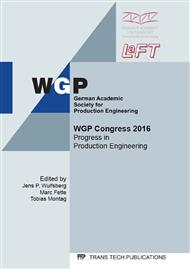[1]
H. Bley, L. Weyand, A. Luft, An Alternative Approach for the Cost-efficient Laser Welding of Zinc-coated Sheet Metal, CIRP Annals - Manufacturing Technology 56(1) (2007) 17–20.
DOI: 10.1016/j.cirp.2007.05.006
Google Scholar
[2]
M. Geiger, K.H. Leitz, H. Koch, A. Otto, A 3D transient model of keyhole and melt pool dynamics in laser beam welding applied to the joining of zinc coated sheets, Production Engineering, Vol. 3, No. 2 (2009) 127-136.
DOI: 10.1007/s11740-008-0148-7
Google Scholar
[3]
M. Schmidt, A. Otto, C. Kägeler, M. Geiger, Analysis of YAG Laser Lap-Welding of zinc coated steel sheets, CIRP Annals, E, 57/1/2008 (2008) P. 213.
DOI: 10.1016/j.cirp.2008.03.043
Google Scholar
[4]
A.F.H. Kaplan, J. Powell, Spatter in laser welding, Journal of Laser Applications (2011) 23(3): 032005.
Google Scholar
[5]
A.F.H. Kaplan, E.M. Westin, G. Wiklund, P. Norman, Imaging in cooperation with modeling of selected defect mechanisms during fiber laser welding of stainless steel, Proc. of International Congress on Applications of Lasers and Electro-Optics (ICALEO), LIA Congress Proceeding (2008).
DOI: 10.2351/1.5061264
Google Scholar
[6]
V.V. Semak, J.A. Hopkins, M.H. McCay, T.D. McCay, Melt pool dynamics during laser welding, Journal of Physics D: Applied Physics 28 (1995) 2443: 2450.
DOI: 10.1088/0022-3727/28/12/008
Google Scholar
[7]
I. Stol, R.P. Martukanitz, Laser welding with beam oscillation. US Patent 6. 740. 845(2004).
Google Scholar
[8]
C. Böerner, Dilger, K., V. Rominger, Harrer, T., Krussel, T., T. Lower, Influence of ambient pressure on spattering and weld seam quality in laser beam welding with the solid-state laser, Proc. of International Congress on Applications of Lasers and Electro-Optics (ICALEO), LIA Congress Proceeding (2011).
DOI: 10.2351/1.5062302
Google Scholar
[9]
L. Nicolosi, F. Abt, A. Blug, A. Heider, R. Tetzlaff, Höfler, H., A novel spatter detection algorithm based on typical cellular neural network operations for laser beam welding processes, Measurement Science and Technology, 23(1) (2011) 015401.
DOI: 10.1088/0957-0233/23/1/015401
Google Scholar
[10]
M. Khan, L. Romoli, G. Dini, M. Fiaschi, A simplified energy-based model for laser welding of ferritic stainless steels in overlap configurations, CIRP Annals, E, 60/1/2011 (2011) p.215.
DOI: 10.1016/j.cirp.2011.03.112
Google Scholar
[11]
H. Ki, P. Mohanty, J. Mazumder, Modeling of laser keyhole welding: Part II. Simulation of keyhole evolution, velocity, temperature profile, and experimental verification, Metallurgical and materials transactions (2002) Volume 33A.
DOI: 10.1007/s11661-002-0191-5
Google Scholar
[12]
J. Volpp, F. Vollertsen, Modeling keyhole oscillations during laser deep penetration welding at different spatial laser intensity distributions, Production Engineering Research and Development 9, 2 (2015) 167-178.
DOI: 10.1007/s11740-014-0594-3
Google Scholar
[13]
A.F.H. Kaplan, Influence of the beam profile formulation when modeling fiber-guided laser welding, Journal of Laser Applications 23. 4 (2011): 042005.
DOI: 10.2351/1.3633221
Google Scholar
[14]
Information on http: /www. schmolz-bickenbach. de/fileadmin/files/schmolz-bickenbach. de/documents/Datenblaetter/6082. pdf.
Google Scholar
[15]
Information on http: /www. atrspa. eu/allegati/prodotti/de/de_S235JR. pdf.
Google Scholar
[16]
R. Fabbro, M. Hamadou, F. Coste, Metallic vapor ejection effect on melt pool dynamics in deep penetration laser welding, J. Laser Appl. 16 (2004) 16–9.
DOI: 10.2351/1.1642633
Google Scholar


